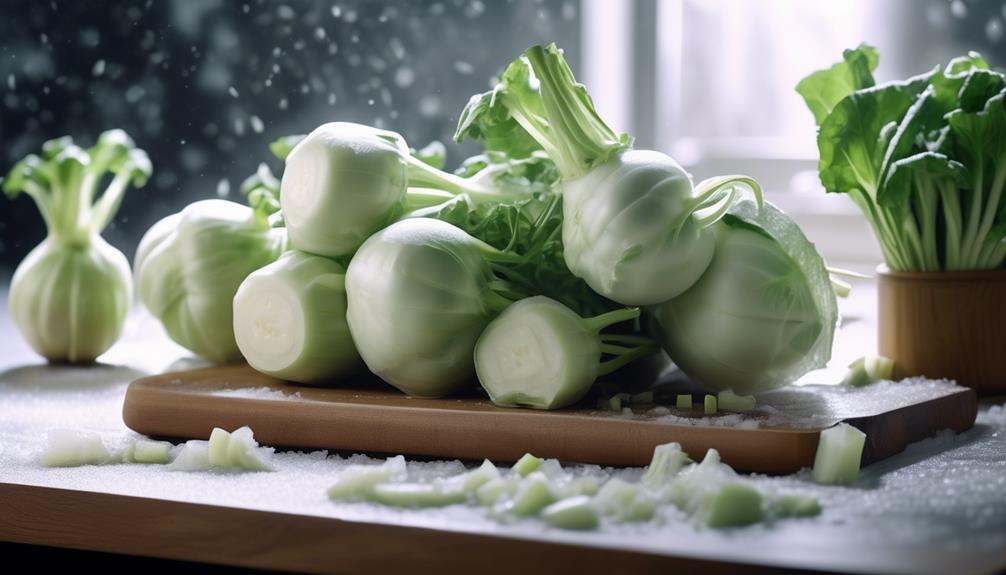Imagine you've just returned from the farmer's market, arms laden with fresh kohlrabi, only to realize you've bought more than you can use before it spoils. You're now faced with the task of preserving their crisp, distinctive flavor for future use.
To ensure your kohlrabi retains its best qualities, you'll need to follow a few key steps before popping them in the freezer. Start by selecting firm, unblemished bulbs and crisp leaves; this choice is crucial as it sets the foundation for successful freezing.
You must then wash, trim, and cut the kohlrabi into uniform pieces, which will guarantee even blanching—a vital process you'll soon discover is indispensable in locking in flavor and nutrients. After blanching, you'll quickly cool the vegetables to stop the cooking process, but how you package them can make all the difference in avoiding freezer burn and maintaining texture.
As you learn the intricate balance of these steps, you'll find yourself on the cusp of extending your kohlrabi's shelf life, ensuring you can enjoy this versatile vegetable all year round.
Key Takeaways
- Choose firm, unblemished bulbs with vibrant leaves
- Select smaller-sized kohlrabi for tenderness and sweeter flavor
- Blanch the kohlrabi in boiling water for 2-3 minutes
- Cool the blanched kohlrabi in ice water and drain thoroughly before packaging
Selecting the Best Kohlrabi
To ensure your kohlrabi freezes well, choose firm, unblemished bulbs with vibrant leaves. When you're market shopping, keep in mind the different kohlrabi varieties available. The most common ones are green and purple, though there isn't a significant difference in taste between them. It's more about your preference for color in your dishes.
Look for kohlrabi that's smaller in size, typically no larger than a tennis ball. These tend to be more tender and have a sweeter flavor profile compared to their oversized counterparts, which can be woodier. Give them a good squeeze; they should feel dense and hefty for their size. If you spot any soft spots, move on to the next bulb.
Don't forget to inspect the leaves. They should be a hearty green, without any yellowing or wilting. These leaves are a sign of freshness and also pack a lot of nutrients. You can even freeze them separately to add to soups or stews later on.
Preparing Kohlrabi for Freezing
Before you stash your kohlrabi in the freezer, you'll need to wash and blanch the bulbs to preserve their texture and flavor. Kohlrabi peeling is essential too, as it helps in texture retention and removes any dirt or impurities. Here's what you'll need to do:
- Clean Thoroughly: Start by washing the kohlrabi under cool, running water. Use a vegetable brush to scrub away any dirt on the skin.
- Peel and Cut: With a sharp knife, peel the tough outer layer of the kohlrabi. Then, slice the bulb into your preferred size — whether that be cubes, sticks, or slices.
- Blanch the Pieces: Bring a large pot of water to a boil. Place the kohlrabi pieces into the boiling water for 2-3 minutes. This step is crucial for halting enzyme activity that can deteriorate the quality over time.
- Cool Down Quickly: After blanching, immediately transfer the kohlrabi to a bowl of ice water. This stops the cooking process and ensures the pieces retain their firm texture.
Following these steps will help you maintain the kohlrabi's quality during freezing, making sure it's as good as fresh when you're ready to use it.
Blanching Process Explained
Having covered the initial steps of preparing kohlrabi for freezing, let's now focus on why blanching is a key part of the process, ensuring that your vegetables maintain their quality over time. Blanching is a brief cooking method where you scald vegetables in boiling water or steam for a short time. This step is crucial as it stops enzyme actions which can cause loss of flavor, color, and texture.
One of the blanching benefits is that it cleanses the surface of dirt and organisms, brightens the color, and helps retard loss of vitamins. It also wilts or softens vegetables, making them easier to pack.
Time determination for blanching is critical; too short won't halt the enzymes, and too long will cook the vegetable and sap nutrients. Here's a quick guide:
| Vegetable Size | Blanching Time |
|---|---|
| Whole Kohlrabi | 3 minutes |
| Kohlrabi Cubes | 1 minute |
| Kohlrabi Leaves | 2 minutes |
After blanching, you must cool the kohlrabi quickly in ice water to stop the cooking process. Then, drain it thoroughly to avoid excess moisture, which can lead to freezer burn. Now, you're all set to freeze your kohlrabi, preserving its freshness for months.
Cooling and Packaging Techniques
Immediately after blanching, plunge your kohlrabi into ice water to rapidly cool it down, halting the cooking process and preserving its quality. This step is crucial in the freezing process as it ensures that your kohlrabi retains its texture and flavor, which are key to successful preservation methods.
Once cooled, it's time to prep your kohlrabi for the freezer. Here's a straightforward, four-step guide to help you package your kohlrabi efficiently:
- Drain Thoroughly: Remove the kohlrabi from the ice water and let it drain completely. Excess water can lead to ice crystals, which may affect the texture.
- Portioning: Divide the kohlrabi into meal-sized portions. This helps with freezer organization and makes it easier to thaw only what you need.
- Wrapping: Wrap the portions in cling film or use vacuum-sealed bags to protect against freezer burn and preserve freshness.
- Labeling: Clearly label each package with the date of freezing. This helps you keep track of what to use first and maintains a more organized freezer.
Storing Frozen Kohlrabi Properly
Once you've packaged your kohlrabi, it's essential to place it in the right part of the freezer to ensure maximum freshness and longevity. The optimal temperature for your freezer should be at or below 0°F (-18°C). This temperature halts bacterial growth and preserves the quality of your vegetables. It's important to avoid the door shelves, as temperatures there can fluctuate with frequent opening and closing. Instead, choose a spot at the back of the freezer where the temperature is most consistent.
If you've opted for vacuum sealing, you've made a great choice. Vacuum sealing removes air, preventing freezer burn and extending the shelf life of your kohlrabi. Make sure the seal is tight and check for any punctures or tears in the bag. If you're using freezer bags or containers, press out as much air as possible before sealing.
Always label your frozen kohlrabi with the date of freezing. It's best to use your frozen kohlrabi within eight to twelve months for optimal taste and texture. Remember to rotate your stock; use the oldest packages first to maintain quality.

